Intel Core i7-10700 vs Core i7-10700K Review: Is 65W Comet Lake an Option?
by Dr. Ian Cutress on January 21, 2021 10:30 AM EST- Posted in
- CPUs
- Intel
- Core i7
- Z490
- 10th Gen Core
- Comet Lake
- i7-10700K
- i7-10700
CPU Tests: Synthetic and SPEC
Most of the people in our industry have a love/hate relationship when it comes to synthetic tests. On the one hand, they’re often good for quick summaries of performance and are easy to use, but most of the time the tests aren’t related to any real software. Synthetic tests are often very good at burrowing down to a specific set of instructions and maximizing the performance out of those. Due to requests from a number of our readers, we have the following synthetic tests.
Linux OpenSSL Speed: SHA256
One of our readers reached out in early 2020 and stated that he was interested in looking at OpenSSL hashing rates in Linux. Luckily OpenSSL in Linux has a function called ‘speed’ that allows the user to determine how fast the system is for any given hashing algorithm, as well as signing and verifying messages.
OpenSSL offers a lot of algorithms to choose from, and based on a quick Twitter poll, we narrowed it down to the following:
- rsa2048 sign and rsa2048 verify
- sha256 at 8K block size
- md5 at 8K block size
For each of these tests, we run them in single thread and multithreaded mode. All the graphs are in our benchmark database, Bench, and we use the sha256 results in published reviews.
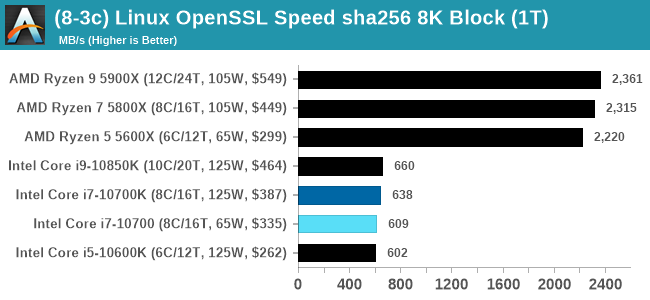
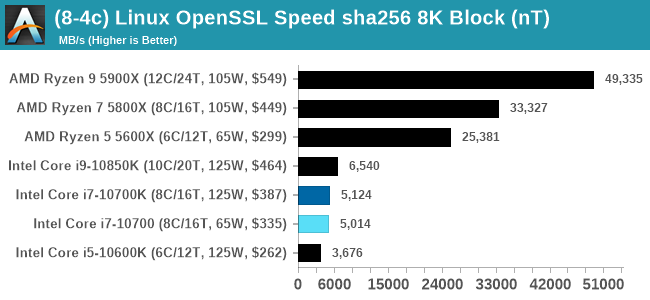
Specifically on the sha256 tests, both AMD and Via pull out a lead due to a dedicated sha256 compute block in each core. Intel is enabling accelerated sha256 via AVX-512 to its processors at a later date.
GeekBench 5: Link
As a common tool for cross-platform testing between mobile, PC, and Mac, GeekBench is an ultimate exercise in synthetic testing across a range of algorithms looking for peak throughput. Tests include encryption, compression, fast Fourier transform, memory operations, n-body physics, matrix operations, histogram manipulation, and HTML parsing.
I’m including this test due to popular demand, although the results do come across as overly synthetic, and a lot of users often put a lot of weight behind the test due to the fact that it is compiled across different platforms (although with different compilers).
We have both GB5 and GB4 results in our benchmark database. GB5 was introduced to our test suite after already having tested ~25 CPUs, and so the results are a little sporadic by comparison. These spots will be filled in when we retest any of the CPUs.

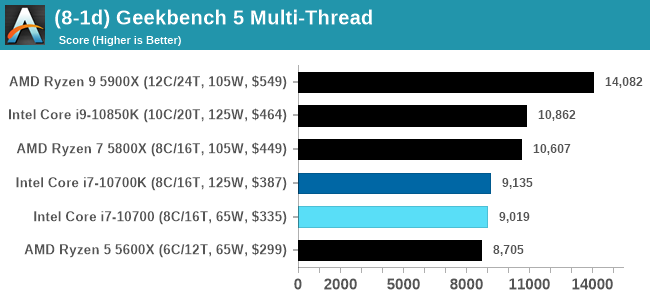
LinX 0.9.5 LINPACK
One of the benchmarks I’ve been after for a while is just something that outputs a very simple GFLOPs FP64 number, or in the case of AI I’d like to get a value for TOPs at a given level of quantization (FP32/FP16/INT8 etc). The most popular tool for doing this on supercomputers is a form of LINPACK, however for consumer systems it’s a case of making sure that the software is optimized for each CPU.
LinX has been a popular interface for LINPACK on Windows for a number of years. However the last official version was 0.6.5, launched in 2015, before the latest Ryzen hardware came into being. HWTips in Korea has been updating LinX and has separated out into two versions, one for Intel and one for AMD, and both have reached version 0.9.5. Unfortunately the AMD version is still a work in progress, as it doesn’t work on Zen 2.
There does exist a program called Linpack Extreme 1.1.3, which claims to be updated to use the latest version of the Intel Math Kernel Libraries. It works great, however the way the interface has been designed means that it can’t be automated for our uses, so we can’t use it.
For LinX 0.9.5, there also is a difficulty of what parameters to put into LINPACK. The two main parameters are problem size and time – choose a problem size too small, and you won’t get peak performance. Choose it too large, and the calculation can go on for hours. To that end, we use the following algorithms as a compromise:
- Memory Use = Floor(1000 + 20*sqrt(threads)) MB
- Time = Floor(10+sqrt(threads)) minutes
For a 4 thread system, we use 1040 MB and run for 12 minutes.
For a 128 thread system, we use 1226 MB and run for 21 minutes.
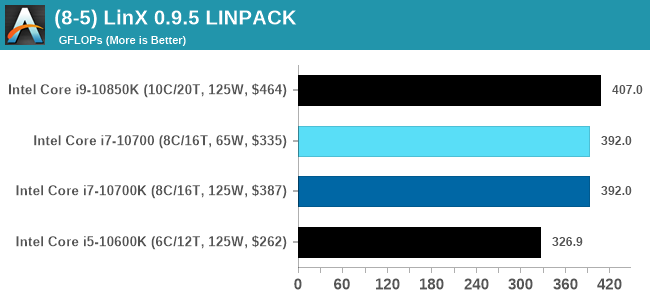
CPU Tests: SPEC
SPEC2017 and SPEC2006 is a series of standardized tests used to probe the overall performance between different systems, different architectures, different microarchitectures, and setups. The code has to be compiled, and then the results can be submitted to an online database for comparison. It covers a range of integer and floating point workloads, and can be very optimized for each CPU, so it is important to check how the benchmarks are being compiled and run.
We run the tests in a harness built through Windows Subsystem for Linux, developed by our own Andrei Frumusanu. WSL has some odd quirks, with one test not running due to a WSL fixed stack size, but for like-for-like testing is good enough. SPEC2006 is deprecated in favor of 2017, but remains an interesting comparison point in our data. Because our scores aren’t official submissions, as per SPEC guidelines we have to declare them as internal estimates from our part.
For compilers, we use LLVM both for C/C++ and Fortan tests, and for Fortran we’re using the Flang compiler. The rationale of using LLVM over GCC is better cross-platform comparisons to platforms that have only have LLVM support and future articles where we’ll investigate this aspect more. We’re not considering closed-sourced compilers such as MSVC or ICC.
clang version 10.0.0
clang version 7.0.1 (ssh://git@github.com/flang-compiler/flang-driver.git
24bd54da5c41af04838bbe7b68f830840d47fc03)
-Ofast -fomit-frame-pointer
-march=x86-64
-mtune=core-avx2
-mfma -mavx -mavx2
Our compiler flags are straightforward, with basic –Ofast and relevant ISA switches to allow for AVX2 instructions. We decided to build our SPEC binaries on AVX2, which puts a limit on Haswell as how old we can go before the testing will fall over. This also means we don’t have AVX512 binaries, primarily because in order to get the best performance, the AVX-512 intrinsic should be packed by a proper expert, as with our AVX-512 benchmark. All of the major vendors, AMD, Intel, and Arm, all support the way in which we are testing SPEC.
To note, the requirements for the SPEC licence state that any benchmark results from SPEC have to be labelled ‘estimated’ until they are verified on the SPEC website as a meaningful representation of the expected performance. This is most often done by the big companies and OEMs to showcase performance to customers, however is quite over the top for what we do as reviewers.
For each of the SPEC targets we are doing, SPEC2006 rate-1, SPEC2017 speed-1, and SPEC2017 speed-N, rather than publish all the separate test data in our reviews, we are going to condense it down into a few interesting data points. The full per-test values are in our benchmark database.
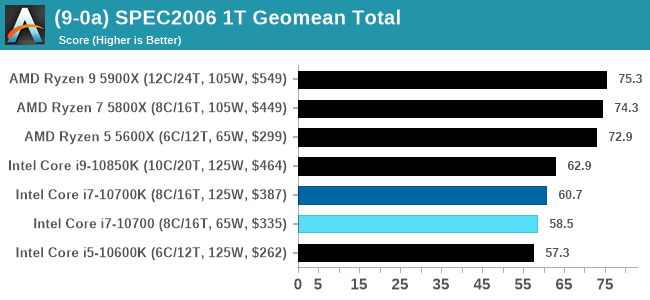
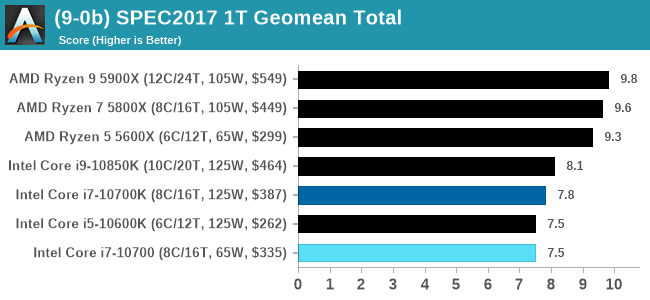
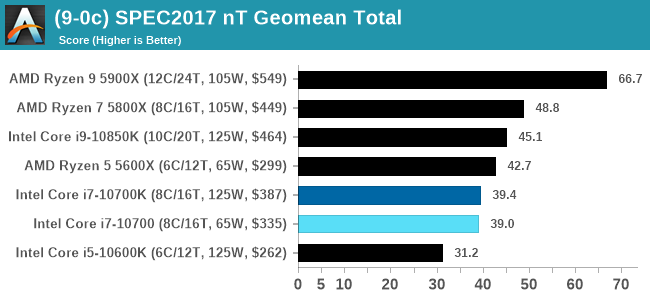
Both of the 8-core Core i7 parts here are handily beaten by AMD's 6-core Ryzen 5 in ST and MT.


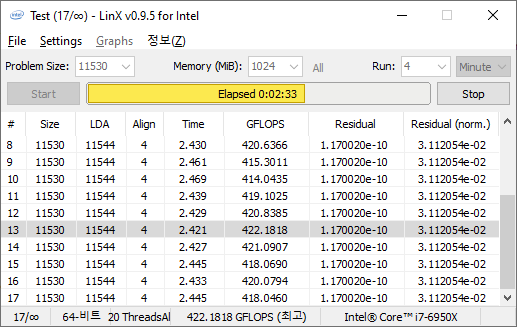








210 Comments
View All Comments
quiq - Sunday, January 24, 2021 - link
I would have liked them to test the processors in addition to the heatsink that comes in the retail box, that would provide a sample of how the product behaves that an end user obtains when buying it. Obviously the use of a heatsink from a 3rd party manufacturer improves the performance of both due to the superior ability to eliminate heat, which helps to maintain the turbo frequencies for longer in both processors.olde94 - Monday, January 25, 2021 - link
one thing i don't see is that the CPU is officially rated 2.9ghz. Not 4.0 as the graphs seems to suggest. We are getting 4.0 with propper cooling, but what i gave it a 90W cooler? Would i end up back at 2.9ghz? We all know that frequency and powerdraw is never a linear curve so we might see 25% lower powerformance at 1/3 the power draw and as such their claim about 65w could be true, but that it peaks if allowed to. I mean don't get me wrong, it's shitty, but is it really that wrong though?noxplague - Monday, January 25, 2021 - link
Dr. Cuttess, thank you as always for these in-depth analyses.I would really like to see how this compares with the previous 9th generation Intel parts (9900, 9700, 9600, etc). However in your bench tool the 2020 and 2019 tests make this difficult. Couldn’t the data be back ported or forward ported and just put N\A for tests that aren’t in both datasets?
I love then bench tool, but it’s recently hamstrung by not allowing for comparisons of 8th gen and 9th gen (and equivalent AMD parts)
Nesteros - Wednesday, January 27, 2021 - link
I was under the impression that TDP was the maximum amount of thermal energy, measured in watts, that a CPU would ever produce and would need to be “removed” by the thermal solution, not the amount of energy measured in watts that a CPU consumes. Surely a processor is not converting all of the power it consumes into heat, else it would be a very efficient space heater and not a CPU.Qasar - Thursday, January 28, 2021 - link
take a look at this :https://www.anandtech.com/show/13544/why-intel-pro...
simply put, intel bases its TDP at BASE clocks, with what they would consider default settings. AMD, bases its TDP, on, for the most part, max power draw. same value, WAY different view of what TDP is between them
Peter-fra - Saturday, February 13, 2021 - link
Dear Anandtech team, thanks a lot for this great clarification of the difference between K and non K Intel products. However, I would like to know what you think about these Geekbench multi-score results showing a gap of around 13% between the 10700 and 10700k on multi-core bench ?=> https://browser.geekbench.com/processor-benchmarks
Since the difference of all core turbo frequency between those 2 processor is around 2-3% (4.7Ghz vs 4.6Ghz) I cannot understand why there would be a 13% gap on this benchmark ?
Does it mean that the Geekbench aggregated data of the 10700 comes from OEM builds with entry level motherboard which doesn't maximize turbo (probably because the VRM are not great) and stay within the intel recommended turbo ?
Scour - Monday, February 15, 2021 - link
That´s the end of my 350W-PSUs :(stealth-katana - Friday, April 2, 2021 - link
The image with the text written with a sharpie on the CPU is making me cringe. 🤣briantim - Wednesday, September 8, 2021 - link
http://home.anandtech.com/show/16343/intel-core-i7...